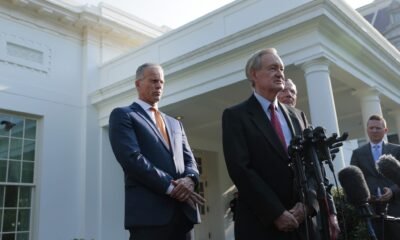Business
Federal Reserve Slashes Key Rate by 0.25% but Signals Caution on Future Cuts

WASHINGTON — The Federal Reserve announced a quarter-point cut to its key interest rate on Wednesday, marking the third reduction this year. However, officials hinted at a slower pace for future cuts, largely due to persistent inflation concerns.
The central bank’s policy-makers now anticipate only two quarter-point cuts in 2025, a notable decrease from the expectation of four cuts previously projected in September. This shift suggests consumers might not see significantly lower rates next year for mortgages, auto loans, and credit cards.
Currently, the benchmark rate sits at 4.3%, following a series of rate adjustments that included a half-point cut in September. Chair Jerome Powell noted that the recent reductions reflect higher inflation readings and a move towards what the Fed considers a “neutral” rate, which neither stimulates nor suppresses economic growth.
Despite these rate adjustments, inflation remains a critical concern. As of October, the annual core inflation rate, which excludes the most volatile items, was reported at 2.8%. This figure still exceeds the Fed’s target of 2%, indicating ongoing inflationary pressures.
Powell emphasized the need for caution: “We’re closer to the neutral rate, which is another reason to be cautious about further moves.” He reassured that the Fed remains on track to continue cutting rates, while also balancing the risk of overheating the economy.
While the job market shows signs of cooling, with the unemployment rate rising nearly a full percentage point in two years, Powell indicated that further cooling may not be necessary to bring inflation below 2%.
During the press conference, Powell elaborated on the Fed’s rate projections. He pointed out that with core inflation expected to drop to 2.5% next year, progress is being made. “That would be significant progress,” he stated, recognizing that while it falls short of the 2% target, it represents improvement over current levels.
Contrastingly, Beth Hammack, president of the Federal Reserve Bank of Cleveland, dissented from this decision. She advocated for maintaining the current rates, citing uncertainties in the economic outlook as the first dissension since September.
Looking ahead, the Fed’s recent quarterly projections indicate an anticipated slight rise in inflation, predicting it will increase from 2.3% to 2.5% by the end of 2025. This poses challenges for future rate cuts, as maintaining lower borrowing costs is crucial in combating inflation.
Powell acknowledged external factors, including potential economic policies proposed by President-elect Donald Trump, that could complicate the inflation landscape. He indicated that the Fed will remain vigilant about external influences but will need clarity on proposed policy details before making consequential decisions.
The Fed’s latest stance highlights its commitment to navigating an evolving economic environment with caution, as inflation remains sticky, and efforts to achieve a “soft landing” intensify.
AP Business Writer Alex Veiga contributed to this report from Los Angeles.

















